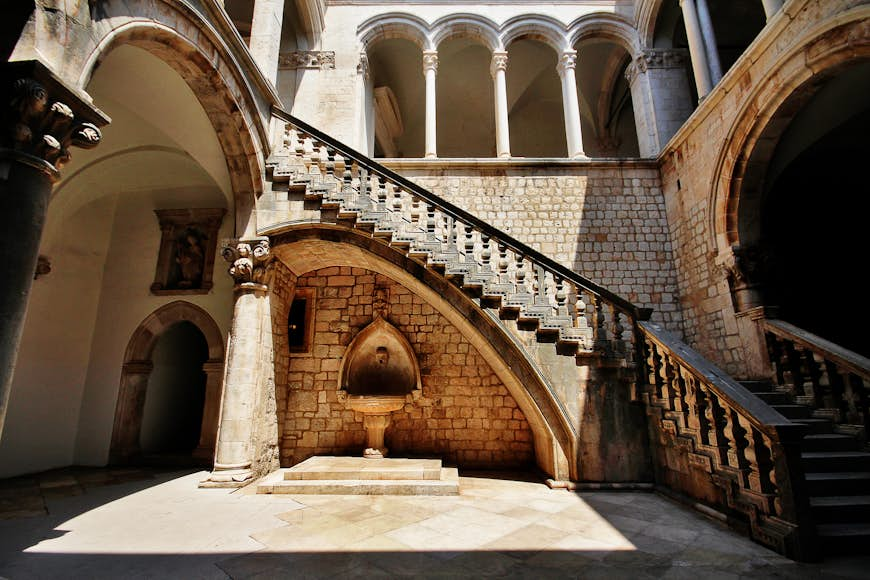Dubrovnik’s greatest museum is arguably the city itself – a living, breathing, labyrinthine slab of more than a thousand years of history, enclosed within some of the most stunningly well-preserved medieval fortifications anywhere on the Mediterranean. However Dubrovnik also has several excellent museums, which are well worth visiting in their own right – ranging from modern and contemporary art to Socialism, and from folk costumes to photojournalism.
Entry to several of the city’s main museums – including the Cultural History Museum in the Rector’s Palace, the Museum of Modern Art Dubrovnik, the Maritime Museum and the Ethnographic Museum – is included on the Dubrovnik Museums ticket. Alternatively, free entry to the museums mentioned above along with the unmissable city walls and use of local public transport is included with a Dubrovnik Card.
Cultural History Museum: best for local history
Dubrovnik’s Cultural History Museum is housed in the Rector’s Palace – a stunning Gothic-Renaissance building in the heart of the old town, which dates from the 15th century and was once the centre of government and the official residence of the Rector of the Republic of Dubrovnik. The 20,000 objects cover the full spectrum of the city’s history and culture – including painting, printmaking, textiles, ceramics, glass, metalwork, furniture, icons, coins and weapons, spanning the period from the 1300s to the early 20th century.
Museum of Modern Art Dubrovnik (MOMAD): best for modern art
Housed in a beautiful mansion built for the wealthy Banac family, Dubrovnik’s Museum of Modern Art is the city’s most prestigious collection of modern and contemporary art. Arranged over four floors, the museum’s permanent collection covers painting, sculpture and prints from the end of the 19th century to WWII – including one of Croatia’s most famous artists, Vlaho Buhovac who was born in nearby Cavtat – as well as more recent works including photography and video. The style of the building itself is in keeping with the Rector’s Palace and other prominent Gothic and Renaissance architecture in the old town, from which the museum is just a short walk away along ulica Frana Supila.

The Maritime Museum: best for maritime history
This is the place to learn about Dubrovnik’s remarkable seafaring history (in which it closely rivalled Venice) from Antiquity right through to the present day – from navigational instruments and historic maps and charts, to intricately detailed model ships, and finds recovered from shipwrecks. Founded back in 1949, the Maritime Museum’s initial collection was based on donations from local residents and objects from an exhibition on Dubrovnik’s seafaring history which went on show in the 1940s. Since then it has expanded to include over 11,000 objects. Appropriately enough, the museum occupies two floors of the medieval St John’s Fort, which guards the entrance to the city’s harbor.
Red History Museum: best for modern Croatian history
One of Dubrovnik’s newest and most interesting museums, the Red History Museum takes a good, honest look at Croatia’s recent past, examining its spell under Communism while part of the former Yugoslavia – a period often skimmed over, and therefore little understood by many visitors beyond the inevitable stereotypes.
The museum is divided into three sections, dealing with the beginnings of Communism, everyday life in the former Yugoslavia (including everything from modern apartments to rock’n’roll and the secret police), and a collection of real-life memories and testaments from people across Croatia who experienced life under Socialism. Fun, informative and interactive – this is how museums should be.
War Photo Limited: best for photography
Founded by photographer Wade Goddard, War Photo Limited is an astonishing collection of photographs which takes a long and unflinching look at the human cost of war. As well as the permanent collection of images from the breakup of the former Yugoslavia, there are temporary exhibitions of images from other conflict zones across the world, including Syria, Lebanon and Ukraine. There’s also a collection of signed, limited edition prints which are available to buy.
At turns harrowing, haunting and heartbreaking, these images are a testament both to the bitter folly of war, and to the work of some of the greatest photojournalists of the modern era, including the likes of Alexandra Boulat, Jan Grarup, Ron Haviv and Ami Vitale. Essential viewing.

Ethnographic museum: best for folk costumes
Housed in the city’s former 16th century grain stores, Dubrovnik’s Ethnographic Museum showcases a rather splendid collection of folk costumes from Dubrovnik and the surrounding region, including Konavle and the Elafiti Islands, as well as folk costumes from neighbouring countries. The costumes are dazzlingly colorful and ornate, and you’ll also find traditional jewellery on display as well as examples of Croatia’s rich lace-making tradition, some of which is inscribed on the Unesco list of Intangible Cultural Heritage.
Love Stories Museum: best for romantics
Dubrovnik’s Love Stories Museum presents love stories from around the world – from local folklore and mythology, to personal stories told through objects donated to the museum. The museum also showcases some well-known romances from films and TV series shot in Dubrovnik – including, obviously, Game of Thrones – and the stories behind well-known love songs.
In some ways you could think of it as a counterpoint to the hugely successful Museum of Broken Relationships in Zagreb – so instead of an axe which someone used to demolish the furniture following a devastating breakup, the objects and stories you’ll find here tend to be ones you might describe as rather more heart-warming.
